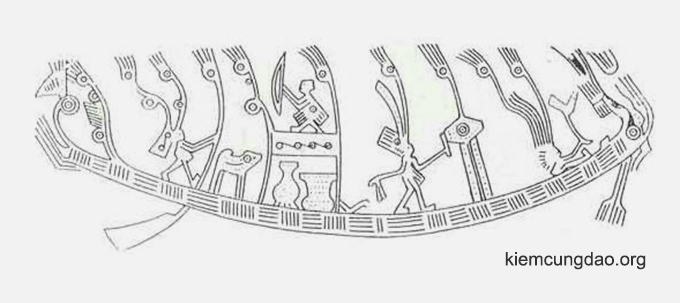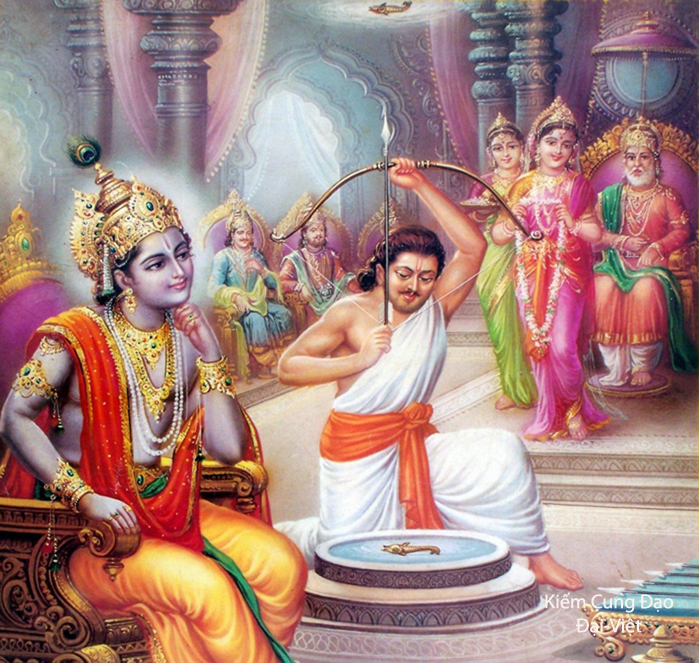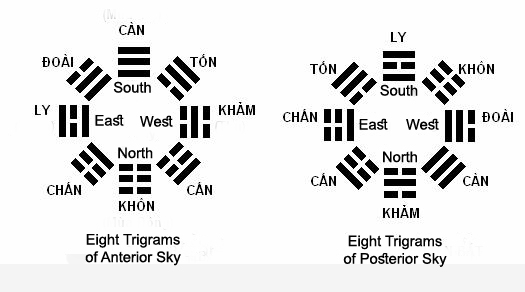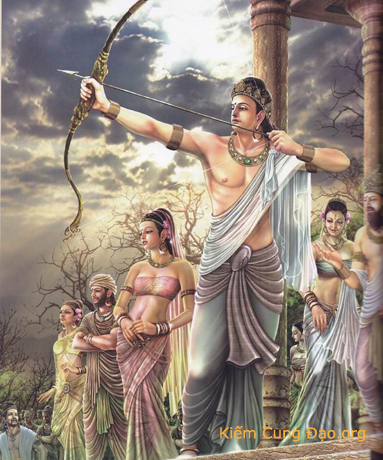THE WAY OF SWORD AND BOW
FROM ĐẠI-VIỆT
The Way of Đại-Việt Archery
Cung-Đạo Đại-Việt
Spiritual Considerations
Among Six Trades (Lục Nghệ)
from the Art of Ancients in the Far-East : 1.The Rites ( Lễ), 2.The Music (Nhạc), 3.The 'Archeriy (Xạ), 4.The Horse Riding and Chariot Driving (Ngự), 5.The Writing and the Littérature (Thư), 6.The Calcul and the Mathématiques (Số), as we have seen clearly that the Archery « Xạ » was in first rank all just after the Rites « Lễ » and the Music « Nhạc ».
This fact has revelated us the crucial impact of the Art of Archery in Civilisations and traditionnal Cultures from the Far-East.

The Way of Archery
Engraved figures on Bronze Drum from Ngọc-Lũ
- Đông-Sơn Culture (700 BC~100 AD) -
And through out the « Rig Veda Sûtra » from India all as through out the « The True Classic of perfect Virtu of the harmonious Vacuum » from Lie-Zi in China , the Archeriy was raised from the rank ofthe Art of Archery - Cung-Thuật into the sublime rank of the Spiritual Way of Archery - Cung-Đạo.
In all first cause, the influence of « Rig Veda Sûtra from India » had could clearly demonstrated in the Way of Archery from Đại-Việt.

In 4000 BC, Prince Arjuna winned the hand of Princess Draupadi
in a competition in which he used the Divine Bow Kodanda (surnamed Mahesh Vaasah - Great Bow)
for firing toward the sky and hitting the rubis eye of the Golden Fish unsteady revolving overhead
by aiming the Golden Fish reflection in a water pan below.
- Rig Veda, India -
The epresentetive example it's the name of the Codified Sequence of Archery « Chấn Thiên Cung - The Bow which Quakes the Sky », from Martial Arts Lineages of Khiển-PHẠN & Khiển-THI, which has obviously benefited from the metaphysical concept mentioned in the Rig Veda through out the anecdote - of the competition for winning the hand of Pricess Draupadi - according to whom Prince Arjuna who had used the Divine Bow Kodanda (surnamed MaheshVaasah - Great Bow) for firing toward the sky and hitting the rubis eye of the Golden Fish - unsteady revolving overhead - by aiming his reflection in a water pan below.
Painting of Prince Arjuna wielding Divine Bow Kodanda. |
 Assistant-Master Nguyễn Phi-Hổ was demonstrating
|
And the one's of the name of the Codified Sequence of Archery « Xuyên Tiễn Cung - The Bow which Fires Piercing Arows » from Martial Arts Lineage of Grand-Master Commander PHẠM-Tường all as the one's of « Thiết Thai Cung - The Bow with Metal Frame » ( 鐵 胎 弓) from Martial Arts Lineage of Grand-Master Xả-ĐÀNG Nguyện HÀ-Hân are also obviously inherited from the metaphysical concept mentioned in the Mundaka Upanishad, (II, 2, 1-4) at Stance 3 and Stance 4 :
Mundaka 2.2.3.
Holding the great bow of Upanishadic wisdom,
the aspirant should fix the arrow of mind,
sharpened with meditation, on its target.
Draw the string with full absorption and shoot at the target.
O my friend, remember immutable, eternal Truth alone is the target.
Mundaka 2.2.4.
“AUM is the bow, atman (individual self) is the arrow;
Brahman (universal self) is the target.
The wise man is one who can penetrate it.
Become one with Him in nature, such as the arrow (which unites with the target) !
Painting of Lord Çakyamuni Bouddha in the Competition |
Assistant-Master Nguyễn Phi-Hổ was demonstrating
|
In addition, the influence of « Kinh Dich - Yi Jing (易 經) from China » - a Treaty originated from Hà-Đồ and Lạc-Thư inherent in Âu-Lạc (Tây-Âu & Lạc-Việt) CIvilization - has also clearly manfested in the Way of Sword and Bow from Đại-Việt - Cung-Đạo Đại-Việt.

Outline of Eight Diagrams
from Anterior Sky and Posterior Sky.
The representative example is Codified Sequence of Archery « Chấn Thiên Cung - The Bow which Quakes the Sky », from Martial Arts Lineages of Khiển-PHẠN & Khiển-THI, « Chấn Thiên Cung - The Bow which Quakes the Sky », from Martial Arts Lineages of Khiển-PHẠN & Khiển-THI, Cung-Thảo « Chấn Thiên Cung » which has obviously inherited from the metaphysical concept mentioned in the Kinh Dich - Yi Jing (易 經) through out the construction of the Codified Sequence ,oriented accorrding to the Eight Trigrams from Posterior-Sky .
The archer shoots Five Arrows :
- Four Arrows in Four directions of Cardinal Points : 1.L'Est, inherent in Trigram CHẤN, 2.L'Ouest, inherent in Trigram ĐOÀI, 3.Le Sud, inherent in Trigram LY, 4.Le Nord, inherent in Trigram KHẢM ;
- One blunt Arrow towards the Divine Sky, inherent in Trigram CÀN (ou KIỀN).
And all as the Codified Sequence of Archery « Xuyên Tiễn Cung - The Bow which Fires Piercing Arrows » ( 穿 箭 弓) from Martial Arts Lineage of Grand-Master Commander PHẠM-Tường which has obviously inherited from the metaphysical concept mentioned in the Kinh Dich - Yi Jing (易 經) through out the construction of the Codified Sequence ,oriented accorrding to the Eight Trigrams from Anterior-Sky.
The archer shoots Four Arrows, by avoiding to shoot in the Southern Direction (corresponding to Trigram CÀN or KIỀN, i.e. the Divine Sky ) :
- Two Arrows in the Western Direction, inherent in Trigram KHẢM ;
- One Arrow in the Eastern Direction, inherent in Trigram LY .
- One Arrow in the Northern Direction., inherent in Trigram KHÔN.
Material Considerations
Since the An-Dương-Vương 安陽王 Period (257 TCN ~ 208 TCN), kingdom Âu-Lạc of Việt people was renamed with the legend of Divine Crossbowreigning over the Cổ-Loa Citatdel and the illustrious Generalissimo Cao-Lỗ was venerated as the Deity of Archery .
Illustrious Generalissimo Cao-Lỗ, the Deity of Archery. |
Sovereign An Dương of Âu-Lạc Kingdom. |
Then throughout the meeting with various Cultures from the Far-East, our ancestors was interested in the choice of the Kaman Steel Bow from India in order to make it a specific War Bow of Đại-Việt, called « Thiết Thai Cung » (The Bow with Metal-Frame).
Kaman Bow with Metal-Frame |
Kaman Bow with Metal-Frame |
Metal Frame Bow from Việt Kingdom, |
Metal Frame Bow from Việt Kingdom, |
Technical Considerations
At the time called «Spring and Autumn Period - 春 秋 時 代» (722-481 BC), the Ancients had already Six Trades (Lục Nghệ) :
1 - The Rites - Lễ (禮) ;
2 - The Music - Nhạc (樂) ;
3 - The Archery - Xạ (射) ;
4 - The Horse Riding and Chariot Driving - Ngự (馭) ;
5 - The Writing and the Literature - Thư (書) ;
6 - The Mathematics - Số (數).
Thus, the two trades « Xạ - Archery» and « Ngự - Horse Driving» had existed before the Military Profession. And the Archery was quoted first among Medieval Weapons from « Eighteen Sections of Martial Arts ».
And the « Archery Art » had assumed an important role on the military plan of Việt people since the ancient times from the Period of Thục-Phán An-Dương-Vương Dynasty of Âu-Lạc Kingdom (258 TCN~207 TCN) into Dynasty Tây-Sơn (1788-1802) Period, with celebrious feat of arms and having bequeathed a certain number of distinguishing weapons in which there were Four Divine Bows :
1. « Bow with Metal Frame - Thiết-Thai Cung - 鐵 胎 弓 » : there's the Bow of General Nguyễn Quang Huy, originally from Phú-Yên. ;
2. « Bow with Horse Tail Hairs - Vỹ-Mao Cung - 尾 毛 弓 » : there's the Bow of the well-read Mandarin La Xuân Kiều, originally of Phù-Cát department subdivision ;
3. « Bow of Black-Veined Aloe Wood - Kỳ-Nam Cung - 楳 枏 弓 » : there's the Bow of General Lý Văn Bưu ;
4. « Bow for Continual Firing - Liên-Phát Cung - 連 發 弓 » : there's the Bow of illustrious generallissimo Đặng Xuân Phong.
Nowadays our Võ-Trận Đại-Việt Academy still preserves precious and rare Three Codified Sequences of Archery which are :
A).« Bow with Metal Frame » - Thiết-Thai Cung 鐵 胎 弓;
B).« Bow which Fires Piercing Arrows » - Xuyên Tiển Cung 穿 箭 弓 ;
C).« Bow which Quakes the Sky » - Chấn-Thiên Cung 震 天 弓.
The Codified Sequence of
« Bow with Metal Frame »
( Thiết-Thai Cung )
鐵 胎 弓

Assistant-Master Nguyễn Phi-Hổ was demonstrating the lunge :
« Nhứt Hành Xạ Tiển Tiên Y Thế » in Codified Sequence of
« Bow with Metal Frame - Thiết-Thai Cung ».
(On the Picture the Composite Recurve Bow is provisionnaly used)
The Codified Sequence of « Bow with Metal Frame - Thiết-Thai Cung » ( 鐵 胎 弓 ) is the famous Sequence in Traditional Martial Arts of Bình-Định, as a prelude to training session for Martial Pedestrian Archery, with techniques noted down throughout a Coded Poem of 15 lines of verse (93 words).
In this Traditional Archery Codified Sequence, the archer shoots Three Arrows in the same Western direction.
It's a celebrious Archery Codified Sequence, taking the famous Bow's name of illustrious Generalisimo Nguyễn-Quang-Huy, under the Tây-Sơn Dynasty (1778-1802 AD), passed down to the posterity by the late Master TRẦN-Quang-Diễn from Xả-Đàng Nguyện HÀ-Hân School System.
Furthermore, this Codified Sequence of « Bow with Metal Frame - Thiết-Thai Cung » ( 鐵 胎 弓 ) has the potential for transforming the Bow into a truthly frightenningly Weapon in the Archer's hands having no Arrrows for firing. The adversaries who aren't well accustomed to the wielding of Sabre, Sword or Spear, will have truthly difficulties for fighting against this « Bow with Metal Frame » from Battlefields Martial Arts of Bình-Định Tây-Sơn.
The Codified Sequence of
« Bow which Fires Piercing Arrows »
« Xuyên-Tiễn Cung »
穿箭弓

Assistant-Master Nguyễn Phi-Hổ was demonstrating the lunge :
« Nam An Bắc Phạt » in Codified Sequence of
« Bow which Fires Piercing Arrows - Xuyên Tiển Cung ».
The Codified Sequence of « Bow which Fires Piercing Arrows - Xuyên Tiển Cung » ( 穿 箭 弓 ), is a rare and precious Codified Sequence owning 16 Coded Lines of Verse (64 words) codifying On Foot Archery Techniques and On Horseback Archery Techniques.
In this Medieval Archery Codified Sequence, oriented , according to Eight Trigrams of Anterior-Sky, the archer shoots Four Arrows, by avoiding to shoot in the Southern Direction (corresponding to Trigram CÀN or KIỀN, i.e. the Sky) :
- Two Arrows in the Western Direction ;
- One Arrow in the Eastern Direction ;
- One Arrow in the Northern Direction.
This is a rare and precious Codified Sequence of Archery from Đại-Việt Medieval Martial Arts, belonging to the School System of Grand-Master Founder Phạm-Tường, who had passed on it to the late Grand Master PHẠM-Hiếu and the late Grand Master LÊ-Hải, whom current successor is the Grand Master PHẠM-Thi.
The Codified Sequence of
« Bow which Quakes the Sky »
« Chấn-Thiên Cung »
震天弓

Assistant-Master Nguyễn Phi-Hổ was demonstrating the lunge :
« Trung-Môn Xạ Tiển » in Codified Sequence of
« Bow which Quakes the Sky - Chấn Thiên Cung »
The Codified Sequence of « Bow which Quakes the Sky - Chấn-Thiên Cung » ( 穿 弓 箭 ), is a prestigious Codified Sequence of Bình-Định Traditional Martial Arts owning 17 Coded Lines of Verse (68 words) codifying On Foot Archery Techniques using as a Ceremonial Prelude to Equestrian Archery demonstratin.
In this Medieval Archery Codified Sequence, oriented according to the Eight Trigrams of Posterior-Sky, the archer shoots Five Arrows :
- Four Arrows in Four directions of Cardinal Points ;
- One blunt Arrow towards the Sky.
It's a rare and precious Codified Sequence of Pedestrian Archery from Đại-Việt Battlefieds Martial Arts, belonging to the School System of the late Grand-Master Khiển-PHẠN and Grand-Master Khiển-THI, whom current sussessor is the Grand Master Ba Phong.
(To be continued...)
VÕ-TRẬN-ĐẠI-VIỆT TRỊNH Quang Thắng |
Bibliography
-
Monde Ancien, Civilisation Orientale, Poème Lyrique, Inde - Rig Veda, Traduction de Alexandre Langlois, Imprimerie Paul Dupont, Rue Jean-Jacques Rousseau, Paris, 1870.
-
Œuvre de Lie-Tzeu, dans Les Pères du Système Taoïste, Léon Wieger, Imprimerie de Hien-Hien, 1913, réédition Les Humanités d’Extrême-Orient, Cathasia, Les Belles Lettres, Paris, 1950.
-
Lie Zi , Le Vrai Classique de la Vertu parfaite du Vide harmonieux, textes traduits et annotés par Fang Sheng, Librairie You-Feng, 2011, ISBN 978-2-84279-493-4, éd. bilingue chinois-français
-
Traité du Vide Parfait, traduit du Chinois par Jean-Jacques Lafitte, Albin Michel, Paris, 1997, ISBN 2226094261 (réédition août 2009, collection Spiritualités vivantes ISBN 978-2-226-09426-1).
-
Le Vrai Classique du Vide Parfait, Benedykt Grynpas, Collection Connaissance de l'Orient, format poche (No 36), série chinoise (1961), Gallimard (plusieurs rééditions dont Gallimard, Folio n° 548, 2011, ISBN 978-2-07-044135-8)
-
Lie Zi, Les Fables de Maître Lie, traduction par Jean Levi, Éditions de l'Encyclopédie des Nuisances, 2014.
Return to Page HISTORY |
Return to Page DISCUSSION |
|---|
Copyright © 2004 - 2018 by ACFDV - All rights reserved.








